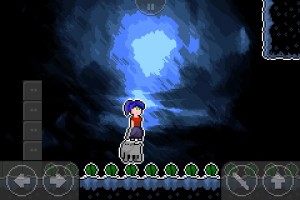(Editor’s Note: What follows is the original review written for the first version the author played. Our site score also reflects the state of the game at that time. Since then, one or more major critiques have been addressed by the developer. For a list of these, see “Addendums” below the original review score at the end of the article.)
What would happen if you scooped the best titles out of your ancient NES game library, tossed them all into a blender, and hit the “on” switch? Daniel Novais, the one-man army behind Mystery of the Japanese Werewolf (Out Now, $0.99; Lite) did just that and the results are very promising. One thing not to expect here is anything close to a coherent plot. To give you some idea, the game begins with a T-Rex stepping off a UFO and uttering a line straight from Castlevania II: Simon’s Quest.
 That in itself is instructive, because the developer’s familiarity with the NES era flows directly into Mystery’s design. Ninja Gaiden and Mario may be name-dropped in the App Store description but the parallels with Metroid flow much stronger, and I sense a healthy dash of Mega Man as well. That should be music to the ears of anyone who’s been waiting for a retro iOS game that actually captures the spirit of retro game design rather than plopping pixelated graphics over bare-bones gameplay.
That in itself is instructive, because the developer’s familiarity with the NES era flows directly into Mystery’s design. Ninja Gaiden and Mario may be name-dropped in the App Store description but the parallels with Metroid flow much stronger, and I sense a healthy dash of Mega Man as well. That should be music to the ears of anyone who’s been waiting for a retro iOS game that actually captures the spirit of retro game design rather than plopping pixelated graphics over bare-bones gameplay.
Mystery serves up a positively huge and criss-crossing environment. In the Metroid tradition, the focus is on exploring and gaining new abilities to break into previously inaccessible areas; in the Mega Man tradition, those abilities come from bosses. With a limited interface on hand, some of those abilities take the form of touchscreen interaction — a great way of expanding a player character’s moveset while keeping a visually simple interface. On the downside, new skills that aren’t tied to Mystery’s virtual buttons are typically of the “tap-to-bust-up-blocks” variety, but it’s an idea that devs would do well to explore further. One could imagine triggering a whole range of special attacks with different swipes, for example.
 In any case, what really comes through in Mystery is the simple joy of pushing into new territory, and expertly crafted environments have the player looping around enough that backtracking doesn’t become much of a concern. Tragically, lack of a map system means there’s still plenty of potential for wrong turns and wasted time. Level design does a great job of corralling the player into the right corridors at first, but that necessarily breaks down once the double jump and a few block-breaking abilities are in hand. This is one respect in which Mystery would do well to channel Super Metroid and not just Metroid!
In any case, what really comes through in Mystery is the simple joy of pushing into new territory, and expertly crafted environments have the player looping around enough that backtracking doesn’t become much of a concern. Tragically, lack of a map system means there’s still plenty of potential for wrong turns and wasted time. Level design does a great job of corralling the player into the right corridors at first, but that necessarily breaks down once the double jump and a few block-breaking abilities are in hand. This is one respect in which Mystery would do well to channel Super Metroid and not just Metroid!
Mystery offers two control schemes. The default “classic” scheme could use some touch area enlargement, especially on the directional buttons — the touch areas on those are only as large as the buttons’ visual size would have you believe, and that’s much too small for a platformer. The “new” control scheme is completely bizarre, turning the unused directional button into a jump button on-the-fly, so your jump button could be on the left-hand side or the right-hand side depending on which way the player character is facing. My lack of ambidexterity is definitely thwarting me here, but it’s an interesting experiment in showing how the function of a single virtual button can dynamically change depending on context. Again, Novais has scratched the surface on something that devs should look into in their search for deeper gameplay — and especially translating classic game mechanics from consoles to the touchscreen.
Mystery holds some impressive aesthetic variation within its retro confines, combining tile-based foregrounds with pseudo-Impressionist backdrops to wonderful effect. The game is supposed to take place inside a spaceship, but you’d never know it from all the caves, gardens, and water temples inside. It’s just too bad the heroine’s sword swinging animation is so half-hearted. It’s an obvious nod to NES-era Ninja Gaidens but will have the player more interested in squashing enemies Mario-style, also a perfectly valid attack option here.
iFanzine Verdict: A great show of what “retro” should really mean, Mystery of the Japanese Werewolf carries more depth than your average iOS platformer thanks to its focus on exploring large environments and gradually expanding the player’s abilities. Now if it could just get some level maps and more responsive controls in updates! Recommended to fans of the original Metroid who think maps are for wussies, and also to 2D-focused developers who are looking for a rich idea mine in the interface department.
Addendum: Improved interface, level maps added.

